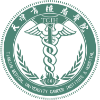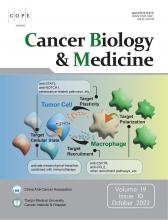Research ArticleOriginal Article
Radiotherapy delays malignant transformation and prolongs survival in patients with IDH-mutant gliomas
Yanwei Liu, Huiyuan Chen, Guanzhang Li, Jing Zhang, Kun Yao, Chenxing Wu, Shouwei Li and Xiaoguang Qiu
Cancer Biology & Medicine October 2022, 19 (10) 1477-1486; DOI: https://doi.org/10.20892/j.issn.2095-3941.2022.0472
Yanwei Liu
1Department of Radiation Oncology, Beijing Tiantan Hospital, Capital Medical University, Beijing 100070, China
2National Clinical Research Center for Neurological Diseases, Beijing 100070, China
Huiyuan Chen
2National Clinical Research Center for Neurological Diseases, Beijing 100070, China
3Department of Neuropathology, Beijing Neurosurgical Institute, Capital Medical University, Beijing 100070, China
Guanzhang Li
2National Clinical Research Center for Neurological Diseases, Beijing 100070, China
4Department of Neurosurgery, Beijing Tiantan Hospital, Capital Medical University, Beijing 100070, China
Jing Zhang
1Department of Radiation Oncology, Beijing Tiantan Hospital, Capital Medical University, Beijing 100070, China
2National Clinical Research Center for Neurological Diseases, Beijing 100070, China
Kun Yao
5Department of Neuropathology, Sanbo Brain Hospital, Capital Medical University, Beijing 100093, China
Chenxing Wu
6Department of Neurosurgery, Sanbo Brain Hospital, Capital Medical University, Beijing 100093, China
Shouwei Li
6Department of Neurosurgery, Sanbo Brain Hospital, Capital Medical University, Beijing 100093, China
Xiaoguang Qiu
1Department of Radiation Oncology, Beijing Tiantan Hospital, Capital Medical University, Beijing 100070, China
2National Clinical Research Center for Neurological Diseases, Beijing 100070, China

References
- 1.↵
- Yan H,
- Parsons DW,
- Jin G,
- McLendon R,
- Rasheed BA,
- Yuan W, et al.
- 2.↵
- 3.↵
- Shaw EG,
- Berkey B,
- Coons SW,
- Bullard D,
- Brachman D,
- Buckner JC, et al.
- 4.↵
- 5.
- Wong QH,
- Li KK,
- Wang WW,
- Malta TM,
- Noushmehr H,
- Grabovska Y, et al.
- 6.↵
- Yu Y,
- Villanueva-Meyer J,
- Grimmer MR,
- Hilz S,
- Solomon DA,
- Choi S, et al.
- 7.↵
- 8.↵
- Rohle D,
- Popovici-Muller J,
- Palaskas N,
- Turcan S,
- Grommes C,
- Campos C, et al.
- 9.↵
- 10.↵
- 11.↵
- Bell EH,
- Zhang P,
- Shaw EG,
- Buckner JC,
- Barger GR,
- Bullard DE, et al.
- 12.↵
- Baumert BG,
- Hegi ME,
- van den Bent MJ,
- von Deimling A,
- Gorlia T,
- Hoang-Xuan K, et al.
- 13.↵
- 14.↵
- 15.↵
- 16.↵
- 17.↵
- Strauss SB,
- Meng A,
- Ebani EJ,
- Chiang GC.
- 18.↵
- 19.↵
- Hu LS,
- Baxter LC,
- Smith KA,
- Feuerstein BG,
- Karis JP,
- Eschbacher JM, et al.
- 20.↵
- van den Bent MJ,
- Afra D,
- de Witte O,
- Ben Hassel M,
- Schraub S,
- Hoang-Xuan K, et al.
- 21.↵
- Gorlia T,
- Wu W,
- Wang M,
- Baumert BG,
- Mehta M,
- Buckner JC, et al.
- 22.↵
- Jiang T,
- Nam DH,
- Ram Z,
- Poon WS,
- Wang J,
- Boldbaatar D, et al.
- 23.↵
- Liu Y,
- Liu S,
- Li G,
- Li Y,
- Chen L,
- Feng J, et al.
- 24.↵
- Liu Y,
- Li Y,
- Wang P,
- Chen L,
- Feng J,
- Qiu X.
- 25.↵
- 26.↵
- 27.↵
- Zhang Z,
- Chan AK,
- Ding X,
- Li Y,
- Zhang R,
- Chen L, et al.
- 28.↵
- Zepeda-Mendoza CJ,
- Vaubel RA,
- Zarei S,
- Ida CM,
- Matthews M,
- Acree S, et al.
- 29.↵
- Venteicher AS,
- Tirosh I,
- Hebert C,
- Yizhak K,
- Neftel C,
- Filbin MG, et al.
- 30.↵
In this issue
Radiotherapy delays malignant transformation and prolongs survival in patients with IDH-mutant gliomas
Yanwei Liu, Huiyuan Chen, Guanzhang Li, Jing Zhang, Kun Yao, Chenxing Wu, Shouwei Li, Xiaoguang Qiu
Cancer Biology & Medicine Oct 2022, 19 (10) 1477-1486; DOI: 10.20892/j.issn.2095-3941.2022.0472
Jump to section
Related Articles
- No related articles found.










